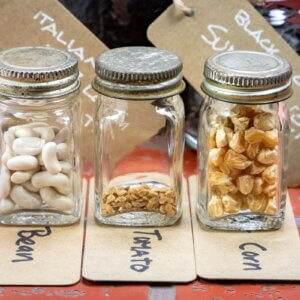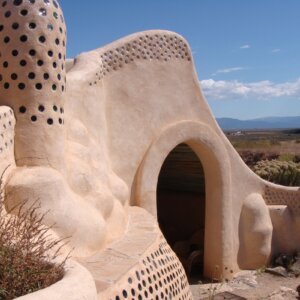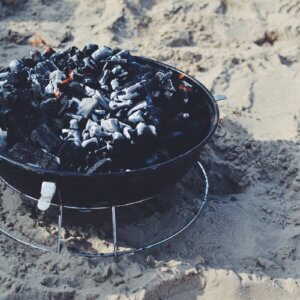
Heating with wood is a beautiful thing. It’s hard to beat sitting next to a crackling fire on a cold winter night as the snow gently falls outside. However, that wonderful feeling comes at a price — a lot of sweat and hard work for many months prior to winter. What happens between the time you cut the wood and the time you enjoy it in your fireplace or wood stove? A lot, actually. And that is what we will be covering in today’s article: The seasoning and storing of firewood.
Also, make sure to check out my other article on the basics of firewood if you are completely new to heating with wood. It will give you a good primer on what it takes to heat with wood.
Seasoning

Seasoning is the process of lowering the amount of water that is contained within the wood. Trees, being plants, contain a LOT of water.
Why Does Wood Need to Be Seasoned?

Water, as you could guess, does not burn well. As such, materials that have a large amount of water also don’t burn. If you want to see for yourself how difficult it is to burn a plant product that is fresh, all you need to do is grab a green leaf off a tree and put it over a lighter or a lit match. It won’t catch on fire. The reason for this is that water has a very high specific heat.
This is a science term used to describe how much energy is required to raise the temperature of a material. Having a high specific heat means that it takes a lot of energy to raise the temperature of the material, in this case water.
If wood has a bunch of water in it, it will need a lot of energy input in order to raise the temperature of the wood to its combustion temperature (the temperature at which it burns). In dry wood, burning kindling usually provides enough energy to get the wood itself to burn.
With wet wood, the kindling might not get the wood to burn at all, or only get it to burn for a short time before it extinguishes itself. Little is more frustrating than trying to get a fire going on a cold winter morning and not being able to do so!
How to Season Wood

To understand how to season wood, you need to understand wood’s makeup and how water leaves the wood. Wood is made of many long cells that run its length. In simple terms, you can imagine wood as a bunch of straws bundled together.
If you have a log, and wait for it to season, the rule of thumb is that it will dry out at a rate of about 1 inch per year. That means if you have a 12-inch diameter log, it will take about 6 years to dry (because it is drying out from all sides). Even a 4-inch diameter log will take 2 years to dry. That is a long time to wait for firewood.

Because it takes so long for wood logs to dry, you first need to split them. Splitting takes a round log covered in bark (which inhibits water loss) and turns it into many smaller pieces (usually with a triangular or rectangular cross-section) that have a single side (or no sides) covered with bark.
Both of these factors (smaller size and no bark) help it dry faster. With splitting, you can make a log that would naturally take the better part of a decade to dry, and make pieces that will dry and be ready for use in a year. And you get a nice workout to boot (unless you use a mechanical log splitter).
Once you have split the wood, you are going to stack it. Wood that is lying directly on the ground will never dry out and just rot. This is good for the soil but not good for winter warmth.
I should say that there are many different ways to stack wood, but they are not all created equal when it comes to optimal drying of wood. When stacking firewood, you want to keep three things in mind: The sun dries out wood, the wind dries out wood, and the ground keeps wood wet. Taking these three things into consideration, you want to create a stack that maximizes exposure to the sun and wind while being off the ground.

First of all, the sun dries out wood. This means that you are going to need to stack the wood in a place where the sun can reach it. It should not be under a tree or any other object that causes a shadow during the better part of the day. Also avoid stacking it directly against a building as this invites insects into the building and can shade the wood. If you must put the stack against a building, the north side is the worst, and the east side is second worst as far as sun exposure goes.

Second, the wind dries out wood. This means that you are going to want to maximize exposure to the wind. Ideally, this means that you should have a stack of firewood that is one length of firewood thick. If you stack two or three rows back-to-back, the middle row will dry out the slowest, and the outside layers won’t dry as fast as they could alone. Orient the stack so the predominant winds in your area hit the stack and blow through it. This increases the amount of air that moves through the stack and therefore, hastens drying.
Finally, the ground keeps wood wet. Stacking wood directly on the ground is not good for the bottom layer. If you do so, the bottom layer will almost certainly not be good for burning. Avoid this problem by stacking the wood on something else. I use old fence boards under my stacks, but anything that keeps the ground from touching the wood will work.
So, all that is to say the optimal stack will be a single line, out in the open, oriented so it is perpendicular to the main wind direction on your land, and isolated from the ground.
Whether or not this is feasible for you is another thing entirely. If you have little land or you require many cords of wood a year, this stacking method might be a bit difficult to do. If you can swing it, I highly recommend it as it dries wood the fastest (short of having a wood kiln).
How Long Does It Take to Season Firewood?

The short answer is it depends. It depends on the type of wood, when you cut the wood, and how the wood is stacked when seasoning.
As far as I know, the only common wood that can burn while green is white ash. I have never used it myself as I don’t have any around me, but if you have it, you can try to burn it without seasoning.
How long other woods take to season depends on the type. In my area, I have shortleaf pine that I can cut in the winter and begin using the next fall. Other sorts of wood may require up to two years to be optimally seasoned.
Another significant factor is when you cut it. If you cut wood in the spring, it is going to be filled with water and take a long time to dry. Late fall and winter are the best times to cut wood as the trees are dormant and have the lowest amount of water in them. If you absolutely must cut wood during the spring or summer, make sure to leave the leaves on for a bit before you cut up the tree. The leaves will draw out some of the moisture through transpiration.
Finally, as already mentioned, how you stack the wood will influence how long it takes. If you use the method I suggested, it will dry the fastest. If you throw it in a big random pile, the stuff on the bottom and in the middle of the pile may never season well.
Storing Wood

Once your firewood is seasoned, it needs to be stored until it is used. Many people store wood in the same stacks that they season it. And that is certainly an option. I, myself, used that option when I first started heating with wood but have since come to change my ways, and now season and store my firewood in different locations.
As mentioned above, for seasoning wood, the optimal location is out in the open in a stack that is one piece of firewood thick. For storing wood for use, however, you have different priorities. Now proximity to the house (or wherever you will use the wood) and keeping the rain and snow off of it are the two most important factors. Because of that, an enclosed wood shed near the point of use is the best place for storing it.
In Conclusion

Seasoning and storing firewood are necessities for anyone who heats with a fire. There are good ways of doing it, and there are not so good ways of doing it. Hopefully, I have helped you understand how to better season and store your firewood so that you can enjoy a winter full of warmth.










































Hi everyone, I’ve been burning wood for over 40 years, and found this interesting advice around 1977
ODE FOR A WOOD BURNER.
BEACHWOOD fires are bright and clear; if the logs are kept a year.
CHESTNUT’S only good they say; if for long it’s laid away.
BIRCH AND FUR logs burn too fast; blaze up bright and do not last.
ELM wood burns like a churchyard mold; even the very flames are cold.
POPLAR gives a bitter smoke; fills your eyes and makes you choke.
APPLE wood will sent your room; with an incense like perfume.
OAK AND MAPLE if dry and old; keeps away the winters cold.
But ASH wood wet and ash wood dry; a king shall warm his slippers by .
Taken with a grain of salt, it’s close to the mark and kind of fun.